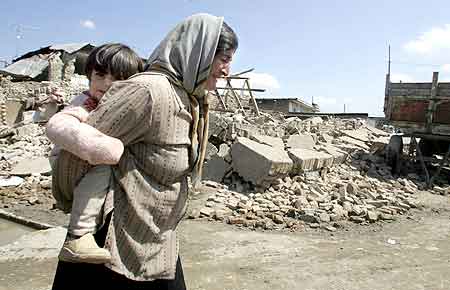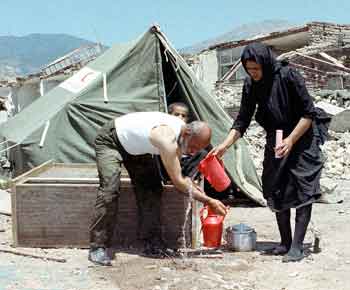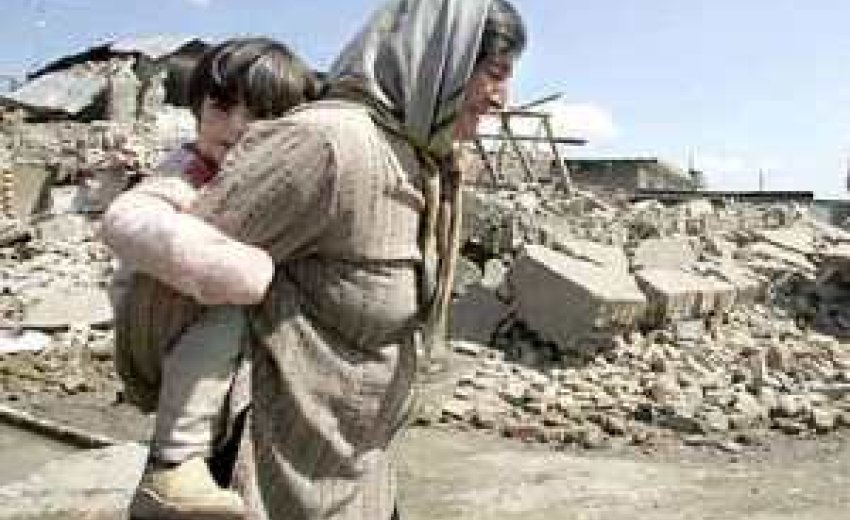TEHRAN - Iran's influential Shiite clerics have a warning: The country's sprawling capital is about to be hit by a killer earthquake. Millions will perish.
 |
| Borujerd:2006 - A 6.1-magnitude earthquake killed at least
70 people and injured more than 1,300, 40 villages were devastated. Photo by Getty Images |
The reason for the coming apocalypse, the clerics say, is simple: Vice has spread through Tehran, and God intends to punish the sinners.
"Go on the streets and repent for your sins," Ayatollah Aziz Khoshvaqt, one of the country's highest clerics, told worshipers during a recent sermon in northern Tehran. "A holy torment is upon us. Leave town."
Even among the many urbane inhabitants of this capital of 12 million, the warning of imminent doom has not been taken lightly. Tehran is one of the most earthquake-prone capitals in the world, built upon the intersection of two major tectonic plates. There are more than a hundred fault lines beneath the city. A quake in the city of Bam, in eastern Iran, killed tens of thousands in 2003.
Fears about Tehran being hit by "the big one" are not new. But the increased seismic activity worldwide -- from earthquakes in remote China to Baja California, to say nothing of the volcanic eruption in Iceland -- has only heightened fears. Never mind that scientists say the exact timing of a quake is nearly impossible to predict.
"If it is vice that causes earthquakes, there should be floods and volcano eruptions as well in Tehran, because all sins are committed in this huge city," said an unemployed resident who gave his name only as Maysam.
Khoshvaqt has gone so far as to alert President Mahmoud Ahmadinejad of the danger, according to a Web site related to Iran's elite Revolutionary Guard Corps. During a recent speech, Ahmadinejad noted that a cleric had informed him that an earthquake was unavoidable.
Swift action has been taken. Ahmadinejad has announced that the government should start work on programs to help at least 5 million people relocate from Tehran in the coming years. Ministers have announced bonuses of up to 50 percent for government employees willing to depart for other regions.
There are even discussions about moving the headquarters of state institutions; the Tehran-based National Museum of Iran has questioned when its collection of 300,000 artifacts can be taken to a safer locale.
 |
| Rudbar-Manjil: 1990 Photo by Getty Images |
The earthquake warnings follow weeks of complaints by religious figures about the loosening of moral standards here, particularly about women who have doffed the traditional Islamic headscarf and long coat with the arrival of spring.
"Women who do not dress modestly....lead young men astray, corrupt their chastity and spread adultery in society, which increases earthquakes," cleric Hojatoleslam Kazem Sedighi told worshipers in Tehran last week.
The prophecies have set Tehran abuzz with rumors and conspiracy theories. People claim to have seen secret refugee camps on the edges of towns. Others are saying that certain politicians have moved their families to other cities.
An e-mail making the rounds -- obviously written by opponents of the government -- asserts that the earthquake will be not the work of God but of Iran's leaders, who will trigger an earthquake with the help of the Revolutionary Guard Corps, the force that cracked down on anti-government protesters following Ahmadinejad's disputed election last year.
"The quake would prevent an attack by the United States," the e-mail says. "Who would attack a country hit by a natural disaster?"
Seismology experts are not pleased by the inexpert analysis.
"Belief in God is very good, but we should not put all responsibility on his shoulders," Bahram Akasheh, a professor of geophysics, said in an interview.
Akasheh is Iran's most senior expert on quakes. He has been studying the ground beneath Tehran for more than 35 years and foresees a bleak future for the capital. Tension has been building along the fault lines for years. There is, he says, a 70 percent chance of a magnitude-7 quake, eventually. He and other scientists have expected such a tremor to strike for the past decade based on previous seismic patterns in Iran.
"Half of the population will die, there will be a complete breakdown of all infrastructure, nearby dams will break, large fires will erupt. Tehran will become completely uninhabitable," he said. "There is no way of really avoiding this. We can't save this city."

